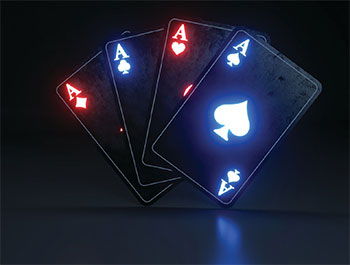BIG ACE GAMES
Video poker players are always hunting those aces
By John Grochowski
 Games featuring enhanced payoffs on four aces have been a video poker staple for more than two decades. Bonus Poker, Double Bonus Poker, Double Double Bonus Poker, Triple Double Bonus Poker – they’re among the most popular games around, and have proven staying power.
Games featuring enhanced payoffs on four aces have been a video poker staple for more than two decades. Bonus Poker, Double Bonus Poker, Double Double Bonus Poker, Triple Double Bonus Poker – they’re among the most popular games around, and have proven staying power.
The fascination with the big ace games is reflected in email from readers. Take these three questions, all received within a few weeks of each other.
DO VIDEO POKER GAMES DEAL FEWER ACES?
Given a five-coin bet, four aces will bring you 400 coins on Bonus Poker or 800 on Double Bonus. The payoff also is 800 most of the time on Double Double or Triple Double, but if the fifth card is a 2, 3 or 4, that leaps to 2,000 on DDB and a whopping 4,000 – as much as a royal flush – on TDB.
Compare that to the 125 on all four of a kinds in Jacks or Better. There has to be some kind of adjustment, right?
There is, but the adjustment doesn’t come from reducing the number of aces dealt.
It comes from adjustments elsewhere on the pay table.
We don’t draw four aces less often on the ace-jackpot games. In fact, those who play at expert level get four-ace hands more often in those video poker favorites. We get four aces once per 5,106 hands in 8-5 Bonus Poker, once per 4,567 hands in 9-7-5 Double Bonus, once per 4,252 hands in 9-6 Double Double Bonus – broken down into once per 16,236 with the low-card kicker and once per 5,761 hands without – and once per 4,578 hands in 9/7 Triple Double Bonus – broken down to once per 14,214 hands with the kicker and once per 6,751 hands without.
The reason we get aces more often in the big jackpot games is because we adjust strategies to go for them more often. Dealt ace of clubs, jack of diamonds, 7 of hearts, 4 of clubs, 2 of hearts in 9-7 Triple Double Bonus, we hold just the ace and give ourselves a long-shot chance at four aces with a kicker. Dealt the same hand in 9-7-5 Double Bonus, we hold both the ace and the jack.
The adjustments to offset the big jackpot hands come on the rest of the pay table. In Bonus Poker, with the smallest aces jackpot, two pairs pay 2-for-1, while they pay only 1-for-1 on the other games. Triple Double Bonus, with the biggest jackpot, pays only 2-for-1 on three of a kind, while the others pay 3-for-1. Other pay table adjustments are made on full houses, flushes and straights.
Smaller payoffs on more frequently occurring hands make it unnecessary to tinker with card frequency to make the payback percentages come out right.
WHY DON’T PLAYERS CHOOSE ACE$ OVER BONUS POKER?
This one came from a reader who had recently stayed at a casino that offered 8-5 pay tables on both Bonus Poker and ACE$ Bonus Poker. The pay tables are identical except for one feature: in ACE$, each ace is marked with a letter, and if the four aces on your screen are in the correct order to spell out A-C-E-S, your prize is 4,000 coins instead of 400.
Starting from the left, the aces have to be in positions 1-2-3-4 or 2- 3-4-5.The non-ace card in your final hand can’t be in the middle. I once had a hand of A-C-9 of diamonds-E-S. The aces were in the proper order, but with that 9 in the middle breaking up the spelling, my return was 400 coins, not 4,000.
It doesn’t happen often enough to add much more to the payback percentage. With an 8-5 pay table, Bonus Poker returns 99.2 per- cent with expert play, while the ACE$ version returns 99.4 percent.
Still, that’s a little extra return with no extra risk. It would seem reasonable for the ACE$ machines to draw more players than the Bonus Poker machines.
That they don’t is part of a long-standing part of video poker. There are many players who don’t know the difference between games, or at least don’t know or fully understand the differences between different pay tables on the same games.
At the beginning of the 1990s, when I was first becoming aware of such things, the Tropicana in Las Vegas had a long bank of Jacks or Better machines. In my mind’s eye, there are 16 machines in the bank, but this was a long time ago, so the memory may cheat a bit.
The games alternated pay tables, so that a 9-6 machine was next to an 8-5 that was next to another 9-6 that was next to another 8-5, and so on. My wife Marcy and I were on a three-night stay, and I played at that bank quite a lot. I observed that players seemed to be choosing games indiscriminately. There were as many players at 8-5 games as at 9-6 machines, even when there were spots open.
I finally broke down and asked a player next to my why he chose that machine when the one on the other side had a higher pay table. He said, “I was on that one this morning. Didn’t win a thing.”
Those who are interested enough and informed enough to read a publication like Strictly Slots might always pick the highest pay table on their game of choice, but that’s not the always case with the general population of casino-goers.
WHY ISN’T THE JACKPOT ON STRAIGHT FLUSHES?
The goal of the game designers is to make a fun game that people will want to come back and play, not necessarily to reflect the true odds of the game. People like the attainable bonus payoff on four aces. It hap- pens often enough that everybody gets it occasionally, and that keeps players coming back.
In Jacks or Better, the game on which most other video poker games are based, the only really big jackpot is the 4,000-coin bonanza for a five-coin bet on royal flushes, which come up only about once per 40,391 hands. Game designers saw a need for a large secondary jackpot to shoot for, something that would leave players feeling happy when they left the game.
Should that jackpot be on the next rarest hand? In Jacks or Better, straight flushes come up about once per 9,148 hands. For an average customer playing at a modest pace of about 500 hands an hour, that’s more than 18 hours between straight flushes. Those hands just don’t occur often enough to provide much positive reinforcement.
Instead, game designers turned to four-ace hands, and also ramped up the paybacks on other fours-of-a-kind. In Double Bonus Poker, four aces come up about once per 4,406 hands, and four 2s, 3s or 4s about once per 1,896.The aces pay 800 coins for a five-coin bet, and the 2s, 3s or 4s pay 400. On a quarter machine, that’s $200 on the aces, $100 on the low cards.
Taken together, on the average quads worth at least $100 will come up about once per 1,316 hands, or once per 2.6 hours of play. If you don’t get such a hand in a given session, chances are someone playing near you will. That’s much more of an attraction to keep players coming back than putting the big payoff on a hand that comes up only once per 18 hours.
Payoffs on straight flushes are sometimes enhanced. I’ve played games with 400- and 500-coin straight flushes, instead of the usual 250. They’re not made the centerpiece of the game, or even a strong No. 2 jackpot to royal flushes. Players are fond of chasing the aces, and the ace-centric games are here to stay.



